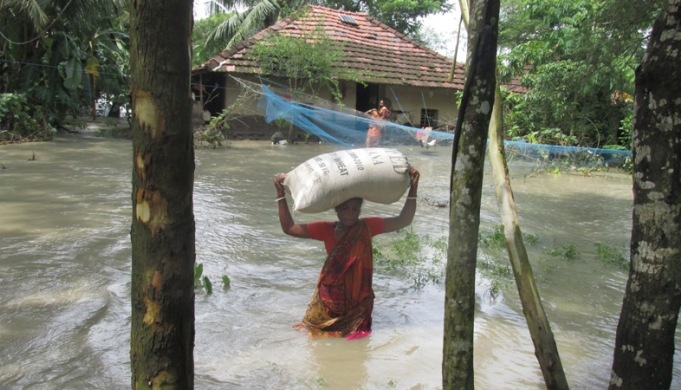Tarun Das, a resident of Silpara village of Sagar island in West Bengal, and his family are now living in a temporary shed at the backyard of his house after staying in a flood shelter for about three months because his house “is no more” after an unprecedented flood in mid-July.
Like Das, thousands in Sagar are still living in temporarily refurbished parts of their damaged houses because they have no other place to go or they also need to look after whatever livestock are still left. Others are either living with relatives’ or have left the island on the mouth of the Ganga.
A rising Bay of Bengal inflicted an “unprecedented” flood on the island considered holy by Hindus. But the authorities have not even acknowledged it as a disaster and there has been almost no coverage by the media, possibly because no one died. Experts point out that it is ironic that while the Maldives, an island country around 300 square kilometres, is in the global spotlight for potential climate change impacts from sea level rise, the recent disaster in Sagar island, slightly smaller with around 225 square kilometres, attracted little attention even at a local level.
The silent disaster
The disaster struck Sagar island, part of Sunderbans delta and about 100 kilometres downstream of Kolkata, during the night of July 12 and early morning next day, leaving 30,000 people homeless. Experts describe it as a tell-tale impact of climate change especially rising sea level. Sunderbans is a global climate change hotspot.
Locals confirm that there was no cyclone, no major rainfall and definitely no prediction. But suddenly during a routine high tide the river Muriganga swelled and jumped – and also breached – the mud embankment and flooded nearly 30 square kilometres covering around 14 villages located in the eastern side of Sagar island, causing huge devastation. No one remembers such a wave before. Mousuni Island, in Namkhana, was also affected but the damage was more pronounced in Sagar. The affected areas are less than 20 kilometres upstream of Muriganga’s confluence with sea.
“During that fateful night, suddenly the saline high tidal water jumped over the river bank and flooded many villages on the eastern bank of Sagar island triggering unprecedented damage in the area,” said Amalesh Mishra of the NGO Paribesh Unnayan Parisad which has been working in the area for almost fifteen years. Mishra claimed that the water breached the embankments at a number of points. Local authorities confirmed that about five kilometres of the embankment was vulnerable and breached at various points.
“I have never seen such high level of water in the river,” Das told thethirdpole.net. “The river jumped over the 10-foot-high embankment.”
Livelihoods wiped out
“Suddenly the saline water gushed in damaging thousands of houses, inundating a vast spread of agricultural fields, destroying wide-ranging betel plantations and filling freshwater ponds. Lives may not be lost but thousands of livelihoods were killed instantly,” said Chhaya Pradhan, a member of the local Gram Panchayat (village government).
Agriculture along with betel production and fishing are the main livelihoods in the area and all have taken a tremendous beating due to the sudden flood. “We have found that that that not only has the salinity level increased in the soil but it has also turned alkaline. These factors will perhaps affect local agriculture for a number of years,” said Sudipta Bhattacharya from another NGO called Specialised and Advanced Foundation of Education (SAFE).
The initial calculated damage is staggering.
Official reports say over 25,000 people had to take shelter in camps, 327 hectares of farmland were destroyed, 108 hectares of betel vine land was devastated and 5,100 freshwater ponds were destroyed. The reports further confirmed that 4,500 houses were either fully or partially damaged and 2,500 cattle were either dead or lost. Unofficially the damage is manifold. “The loss must be in tune of Rs 100 crores (US$16 million),” said Mishra. Local authorities however received far less to distribute among affected people.
Sundarbans face highest sea level rise
According to experts changing climate was to blame for the flood. They warn that July 12 was only a trailer of things to come in the near future.
“The sea level rise in the area is around 8 mm per year, which is not only highest in the country but also one of the highest in Asia and more than double the global average of 3.2 mm per year,” observed Sugata Hazra, a professor of oceanography and a climate change expert from Jadavpur University in Kolkata. “Add to that, an annual subsidence of 4 mm and you are sitting on a volcano. It is only natural that Sagar and the Sunderbans will have to face such climate change triggered inundation more frequently.”
“Sunderbans (within which Sagar falls) has long been identified globally as a climate change hotspot and recent sudden inundation in Sagar without any prior forecast can be linked with changing climate,” agreed Anurag Danda, in charge of Sunderbans division in WWF-India.
Over the past century, the burning of fossil fuels and other human and natural activities has released lot of heat trapping gases (called greenhouse gases) into the atmosphere; over 80% of that has been absorbed by oceans. This has led to huge thermal expansion and sea level rise. The warming climate has also triggered melting of glaciers and polar ice cap adding further water to sea and causing it to rise. Incidentally the Sunderbans area and its immediate surroundings has been identified as a “climate hotspot” in a series of international reports including the recently published Intergovernmental Panel on Climate Change report.
The climate action plan of the West Bengal government also warned of rising sea level in the area and predicted that even a 25-foot water surge was possible.
“A 12 feet surge has devastated Sagar, earlier a 110 km strong Cyclone Aila had all but destroyed south Bengal including Kolkata. Much stronger climate events are predicted for the area. I do not know what will happen if such events hit the area,” said Hazra.
Experts observe that the state government has not yet taken any significant steps to counter climate inflicted calamities. “There has been no awareness at all. The money for the embankment has gone back; there has been no effort on either adaptation or mitigation. The Sagar event is just a small reminder of what can happen,” said one senior bureaucrat who spoke on condition of anonymity.
In response, Javed Khan, the state’s minister in charge of disaster management, said, “We are planning to soon organise an international level meeting to finalise our roadmap for preparing and countering events triggered by climate change.”

